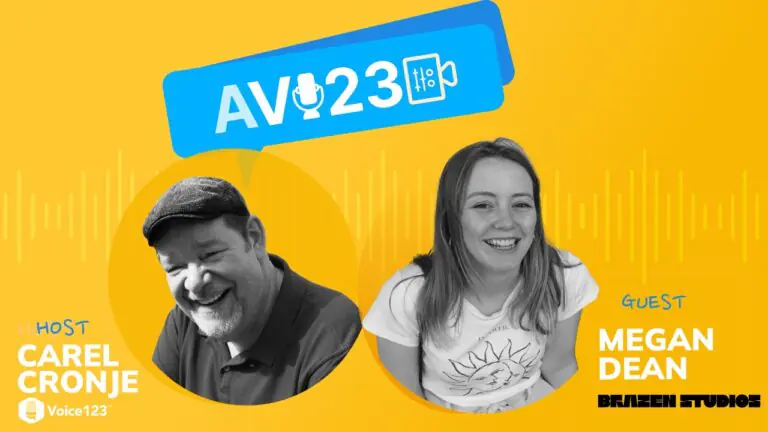Digital audio advertising is a unique marketing tool that enables brands to engage directly with audiences through podcasts, programmatic audio, and digital audio. In this episode of AV123, by Voice123, Kirsten Tannen, Senior Vice President of Accounts at Direct Results, shares how brands can use digital audio advertising to hook their audience!
Listen to the full episode here:
What is digital audio advertising?
Digital audio advertising uses audio formats like radio, podcasts, or streaming services to deliver marketing messages and promotional content to listeners. Audio advertising has an emotional impact that stands out from other types of advertising. As Kirsten explained, “Audio is theater of the mind… storytelling is so important. If you don’t have a story behind it, it’s just going to go in one ear and out the other.”
With the rise of podcasting, audio advertising has become popular for brands to engage niche audiences through loyal listeners who respond to personalized, long-form storytelling. Kirsten explains, “This ability to just be very true to yourself… it gives brands the chance to be honest with their listeners about who they are.”
Types of audio advertising

1. Live reads: These unscripted ads, delivered by podcast hosts or radio personalities, are highly effective because they feel personal. “Give them a few copy points,” Kirsten advised, “but let them spitball and freestyle to keep the personalization intact.”
2. Pre-recorded ads: This type of audio advertising is widely used because it can be customized for scaleable campaigns across platforms. Brands can fine-tune their messaging to ensure consistency across various channels, from streaming services to traditional radio.
3. Programmatic audio advertising: Programmatic audio uses data to target ads precisely based on demographics, location, or even weather conditions. Kirsten highlighted this as a growing trend, saying, “You can serve an umbrella ad when it’s raining or a grilling ad when it’s sunny.”
4. Sonic branding: Think jingles or sound cues that make brands instantly recognizable. “It’s about triggering memory and brand recognition,” Kirsten said. Sonic branding creates an emotional connection, ensuring that brands stay top-of-mind with consumers.
How to succeed in digital audio advertising
1. Be authentic
“Stick to what makes you who you are as a brand,” Kirsten urged. Authenticity builds trust and helps you target a specific audience and build a long-term relationship with them. Hire professional voice actors for audio ads to make your stories even more powerful.
2. Keep it simple
A simple message enhances the impact on listeners. “If you’re rambling and not getting to the call to action… you’re going to lose someone’s attention,” she warned.
3. Leverage data
Use tools like programmatic audio and A/B testing to refine your messaging. Kirsten shared, “We can A/B test creative and see which one performs better, optimizing as we go.”
4. Target the right audience
Understand your audience and what platforms they’re most active on so you can create tailored ads. “If I’m targeting moms with kids at home, I’m not going to run a rock-and-roll ad with a heavy dad voice,” Kirsten said.
5. Keep your CTA’s concise
A strong, clear CTA is critical. Kirsten stressed, “A person has a short memory. Make it easy to remember with a simple URL or promo code.”
6. Track and optimize
Modern tracking tools, like pixel tracking and keyword targeting, provide insights into campaign performance, allowing you to enhance your campaigns with targeted audio ads.
The power of storytelling in digital audio advertising
One of the most compelling aspects of digital audio advertising is its ability to tell stories that resonate deeply with listeners. “Audio is storytelling,” says Kirsten. “If you don’t have the story, it’s not going to pull the listener in.” Stories engage the imagination, inviting listeners to visualize scenarios and connect emotionally with a brand’s message, creating a memorable and impactful experience.
From live reads that leverage the natural conversational tone of a trusted host or through narrative-driven packaged audio ads, storytelling transforms ads into engaging content. A well-crafted audio story doesn’t just sell a product—it builds a brand identity that stays with listeners, creating a personal connection to the hosts and the stories they share,
Final Thoughts
Digital audio advertising offers a unique blend of authenticity, emotional resonance, and technological precision, allowing brands to connect with audiences in ways other mediums simply cannot.
As Kirsten noted, “It’s a marathon, not a sprint. Build trust, stay authentic, and action will follow.”
Ready to craft compelling audio ads for your brand? Hire professional voice actors on Voice123 or use Voice123 Enterprise for complete project management.
And don’t forget to subscribe to AV123 on your favorite podcasting platform for the latest AV insights!
FAQs
Audio marketing involves using audio content, such as ads, podcasts, or streaming audio, to promote products or services through the power of storytelling and engaging sound design.
Identify your target audience and craft a concise, compelling message with a strong call to action. Use a professional voice over to produce high-quality audio that aligns with your brand’s tone and values.
Audio advertising is highly effective because it fosters emotional connections and builds brand recall through storytelling and sound while delivering measurable results with advanced targeting and tracking tools.
Audio-visual advertising combines sound and visuals, such as TV commercials or online video ads, to engage audiences and capture attention.














